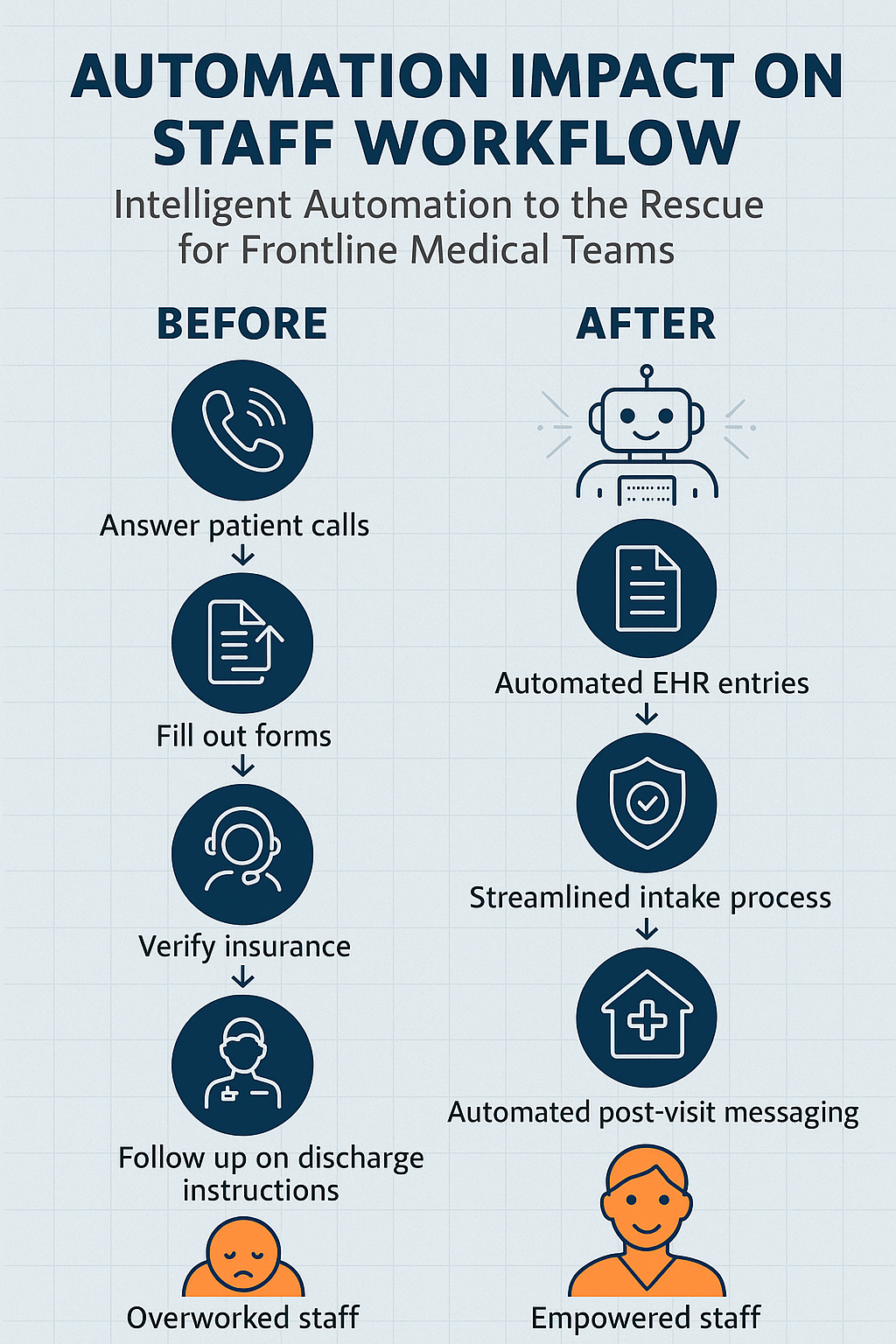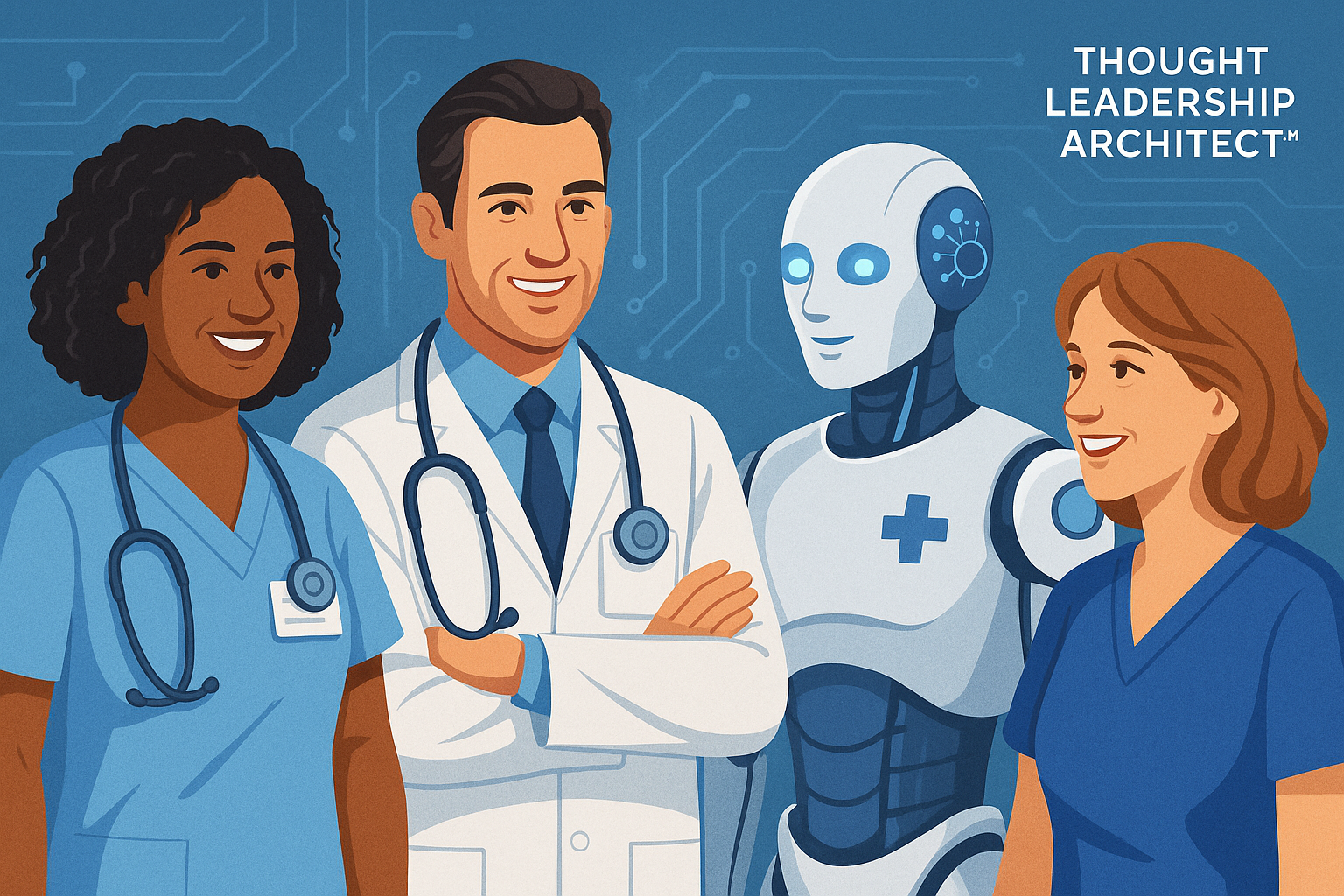Your cart is currently empty!
Burnout. Turnover. Chronic understaffing. These aren’t just HR problems in 2025—they’re critical threats to healthcare delivery, especially in hospitals, skilled nursing facilities (SNFs), and long-term care centers.
With frontline teams stretched to the brink, healthcare leaders are turning to a new kind of teammate: intelligent automation. From AI-powered scribes and triage bots to automated scheduling and supply tracking, digital assistants are emerging as force multipliers that can relieve pressure, restore focus, and reimagine workforce efficiency.
This isn’t about replacing humans—it’s about supporting them, intelligently.
The Staffing Crisis Is Now Systemic
Even before the pandemic, healthcare was showing signs of workforce strain. But recent years have turned cracks into chasms:
- 1 in 5 nurses plan to leave their jobs by the end of 2025¹
- Turnover costs in skilled nursing exceed $60,000 per nurse²
- Frontline clinicians spend up to 50% of their time on non-clinical tasks
“We’re not facing a talent shortage—we’re facing a task overload,” says Dr. Ayana Brill, Chief Clinical Officer at HopeBridge Health. “The best way to save the workforce is to support it with smart systems.”
What Is Intelligent Automation in the Clinical Setting?
Intelligent automation combines AI, machine learning (ML), robotic process automation (RPA), and natural language processing (NLP) to perform repetitive, rules-based, or data-heavy tasks—freeing up human staff for higher-value work.
In hospitals and care facilities, this includes:
- Clinical documentation and note-taking
- Automated patient triage and intake
- Staff scheduling and credentialing
- Predictive analytics for staffing levels
- Equipment and medication inventory tracking
- Digital assistant support during shift changes or chart reviews

Where It’s Working: Use Cases for Relief and ROI
1. AI Scribes & Documentation Tools
Nurses and physicians spend 1–2 hours per shift charting. AI scribes like Nuance DAX, Suki, and custom GPTs can automatically:
- Transcribe patient conversations
- Populate EHR fields
- Suggest diagnostic codes
- Prepare discharge summaries
“We reduced nursing documentation time by 38%—and gave that time back to patients,” says Marcus Kim, RN and Tech Integration Lead at Northview Medical Center.
2. Automated Staff Scheduling
Facilities using AI-powered scheduling tools (e.g., WellSky, ShiftWizard, or internal GPT-based models) have:
- Cut down last-minute call-outs
- Improved shift satisfaction
- Balanced workloads across units
Smart systems can also predict burnout risk by analyzing patterns in overtime, patient load, and time off.
3. RPA for Admin Tasks
Robotic process automation handles repetitive back-office work such as:
- Credential renewals
- Insurance verification
- Inventory logs
- Follow-up appointment reminders
One SNF chain reported a 65% reduction in administrative errors after deploying RPA for admissions and discharge processes.³
4. Triage and Digital Front Door Assistants
AI-powered symptom checkers and intake bots can:
- Pre-screen patients before arrival
- Route cases to appropriate teams
- Alert staff to red-flag symptoms
These tools reduce nurse triage volume, cut ER intake time, and allow teams to prioritize urgent needs.
Benefits: Not Just Efficiency—Emotional Relief
The ROI of intelligent automation isn’t just financial—it’s deeply human.
✅ Lower Burnout Rates
When clinicians spend more time with patients and less time on paperwork, engagement and retention improve.
✅ Greater Job Satisfaction
Teams feel supported, not replaced. Automation acts as a digital co-worker, not a competitor.
✅ Improved Patient Experience
Less stressed staff deliver better care—and automation ensures fewer errors and missed follow-ups.
✅ Cost Reduction
Hospitals report 15–20% operational savings when combining automation with lean workflow design.⁴
Getting Started: How to Introduce Automation Without Fear
- Start Small & Safe
Begin with low-risk, high-frustration tasks: shift scheduling, note transcription, or inventory tracking. - Involve Frontline Voices
Co-design tools with nurses, aides, and support staff. They know where the pain points are—and where help is needed most. - Educate, Don’t Mandate
Offer training and real-world demos that highlight how AI supports rather than replaces. - Maintain Human Oversight
Always provide clear opt-outs, human-in-the-loop checkpoints, and escalation paths for automation decisions. - Track Results & Celebrate Wins
Highlight saved hours, reduced overtime, or increased patient satisfaction. Turn tech success into staff morale.
Real-World Case Study: Harmony Hills Long-Term Care
Facing 35% turnover and rising agency costs, Harmony Hills LTC deployed:
- AI-generated nurse shift summaries
- A custom GPT for family Q&A and discharge support
- RPA for medication refill logs and vitals charting
Within 6 months:
- Nurse call-outs dropped 22%
- Overtime hours decreased by 30%
- Family satisfaction scores rose 14%
“We didn’t add headcount—we added breathing room,” says Marjorie Lane, DON at Harmony Hills. “That’s what kept our team together.”
What’s Next? The Rise of the AI-Augmented Clinical Team
As AI tools evolve, we’ll see:
- Voice-enabled assistants that follow nurses throughout rounds
- Predictive dashboards that recommend staffing adjustments before crises hit
- Digital onboarding bots that handle new employee orientation and compliance
- Custom GPTs that serve as internal policy experts, FAQs, and documentation assistants
The future isn’t AI versus the workforce. It’s AI alongside the workforce.
“Great leaders won’t just fix staffing gaps. They’ll future-proof their teams,” says Sharif McLellan, Healthcare Workforce Strategist at CareIQ. “Automation is the new ally in resilience.”
Key Takeaways
- Healthcare’s frontline staffing crisis demands smart support, not just more hiring.
- Intelligent automation—AI scribes, RPA, GPTs—can relieve burden without reducing headcount.
- Benefits include lower burnout, improved efficiency, stronger morale, and better patient outcomes.
- Successful adoption requires staff involvement, clear training, and ethical implementation.
- Hospitals, SNFs, and LTCs that integrate digital teammates now will lead in retention, outcomes, and operational agility.
Bibliography
- American Nurses Foundation. 2025 Workplace Pulse Report.
- National Investment Center for Seniors Housing & Care. Staffing Turnover Study, 2024.
- Harmony Hills LTC. Automation Pilot Summary Report, Q1 2025.
- Deloitte Health. 2025 Automation Impact Assessment: Healthcare Sector.
- Interview with Dr. Ayana Brill, HopeBridge Health, March 2025.
#HealthcareBurnout #NurseSupport #AutomationInHealthcare #AIAssistants #DigitalHealth #SmartFacilities #WorkforceResilience #HealthcareInnovation #CustomGPT #LongTermCareLeadership



Leave a Reply